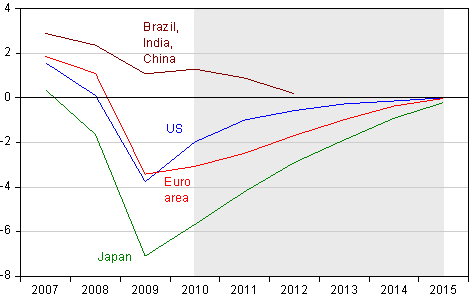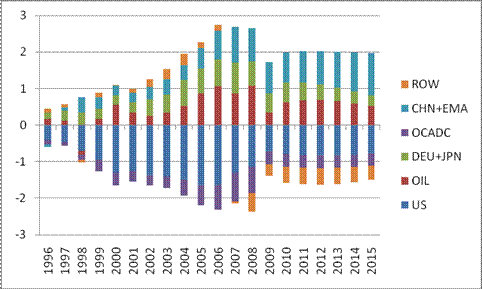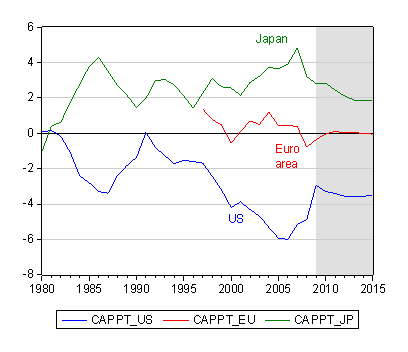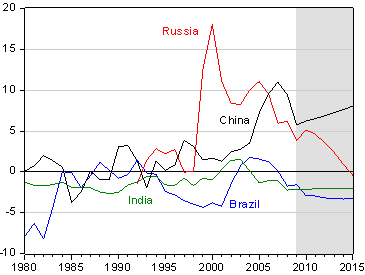From an article in the newest issue of GlobalAsia:
Only a few months ago, policymakers around the world were confronted with a series of challenges that, while substantial, seemed relatively well defined. International organizations such as the International Monetary Fund and the Organization for Economic Cooperation and Development highlighted the challenges of a two-speed recovery: emerging markets racing ahead, advanced economies plodding along. Global financial imbalances, particularly in current accounts, were a worry, but there were promising signs that growth and rebalancing in the United States and China would prove durable.
The prospects for a sustained global recovery now seem much less certain. …
…Most forecasters have revised downward their estimates for growth in the US and Europe (note 1). Anxiety over the durability of Chinese growth remains. Against this backdrop, the resurgence in the US trade deficit combined with the reluctance of the Chinese to allow further currency appreciation suggests that sustaining both growth and rebalancing will be much more difficult than policymakers earlier believed. The failure of the US to further expand short-term fiscal and monetary stimulus — despite ample evidence of economic slack and little evidence of inflation or crowding out — means that policymakers in other countries must step into the breach if a global recovery with rebalancing is to be effected.
Greater fiscal stimulus in the current account surplus countries and greater currency appreciation on the part of the East Asian economies will be needed. In the absence of forceful action, a relapse into global stagnation and widening imbalances is likely.
The entire article is here. Here are some key graphs.

Figure 1: Output gaps as a share of GDP, for US, Euro area and Japan and for Brazil, India and China aggregate (PPP GDP weighted). Shaded area denotes forecasts. Source: IMF, World Economic Outlook (April 2010), World Bank, Global Economic Prospects (2010).

Figure 2: Current account balances as a share of world GDP. 2009-2015 data are IMF projections.
US is United States, OIL is oil exporting countries, DEU+JPN is Germany plus Japan, OCADC is other advanced developed countries, CHN+EMA is China plus other emerging Asia, and ROW is rest of the world. Source: IMF, World Economic Outlook, April 2010.

Figure 3: Current account as a share of GDP, for US, Euro area and Japan. Shaded area denotes forecasts. Source: IMF, World Economic Outlook (April 2010).

Figure 4: Log USD real exchange rate (depreciation is up; left scale), and net exports to GDP (right scale) and net exports to GDP ex.-oil (right scale). Source: BEA, 2010Q2 advance release, Federal Reserve Board, and author’s calculations.

Figure 5: Current account as a share of GDP, for US, Euro area and Japan. Shaded area denotes forecasts. Source: IMF, World Economic Outlook (April 2010).
From the Policy Implications:
There is little chance of overheating in the short term in the US, or other advanced countries. Rather, the greater risk is of deflation, combined with stagnant growth. On the other hand, with the likelihood of a two-speed global recovery becoming ever more apparent, the possibility of overheating is more pronounced in emerging markets.
Global adjustment of current account balances is not proceeding apace — at least not with the current configuration of policies. Continued consumer retrenchment in the US will help reduce the US current account deficit, but northern European fiscal retrenchment is not helpful. In addition, the failure of the Chinese (and other current account surplus countries) to resume currency appreciation means that the quickest means of effecting some adjustment has been put on hold — and cannot be deferred indefinitely. At some juncture, high unemployment combined with a burgeoning trade deficit will increase the likelihood of a destabilizing trade conflict.
A textbook approach to stabilization policy, given the large amount of slack in the American economy, suggests that the US should undertake additional fiscal stimulus, and extend quantitative and credit easing. Since it is unlikely that there will be much progress along these lines, the successful transition to a growth trajectory combined with rebalancing will require more — not less — initiative on the part of policymakers in Europe and Asia. In those countries with some fiscal space, greater stimulus should be undertaken (note 12).
I finished the piece on September 6th; the macroeconomic news since then has only reinforced my views that fear of inflation in the advanced economies should not paralyze policymakers.
The other articles in the symposium “G-20 in Seoul A Chance to Repair The Global Economy”, edited by Barry Eichengreen and David Plott, are by SaKong Il, Richard Portes, Barry Eichengreen, Choong Ahn Yang, and Alan Alexandroff.
Unfortunately, what we will get is fiscal restraint from Europe, continued reliance on export-led growth from Asia (encouraged by the weak response from Timmy and company), and less fiscal expansion from Congress. I lay part of the blame on the Fed for failing to acknowledge that it doesn’t matter anymore. About all Ben can do now is engineer a collapse of the euro bloc (if the ECB fails to counter his moves).
don,
Check out Macroman. The view from London is Euro markets are moving on Fed QE talk.
Also some terribly humorous jokes like “If the Chinese are interested in Greek assets, maybe we should have them contact the British Museum.”
You have to love English humor. Now if we could just pawn off the Smithsonian….
http://macro-man.blogspot.com/
Global Asia article
If global rebalancing aims at rectifying current accounts, only China,Japan are having spared capacities (Fig 5) as India,Russia,Brazil are showing a negative trend of their CA.
Europe euro zone is balanced (Fig 3)(works to be done are within the Eurozone)
Figure 4 of the same shows no correlation between the usd exchange rate and the US exports ~0.4 as of year 2010. After claiming that earth was flat, countries are finding concavities in their lines of export products.
Rebalancing is on the way but the process reveals more of the domestic shortfalls than of the partners countries turpitude.
Unfortunately, what we will get is fiscal restraint from Europe, continued reliance on export-led growth from Asia (encouraged by the weak response from Timmy and company), and less fiscal expansion from Congress.
We’re getting QE2 (bad IMO). You’re not going to solve the largest levered debt crisis by issuing more debt.
The new congress is not going to pass another large spending-based stimulus and I am not sure if the lame duck session will be able to accomplish it. If anything, we will get stimulus in the form of tax breaks for business combined with offsetting spending cuts, perhaps across the board. Will Obama veto it? If so, then I believe that will be the spark that moves the animal spirits to the dark side, i.e. double dip as the spirits see a slowing economy, a rising fiscal deficit, and a gridlocked congress.
It’s probably just my computer, but the link leads me to a page in what seems like a foreign alphabet.
Who’s been working on “global re-balancing”?
The US consumer zipped his/her wallet shut, and that’s the only “work” that has done.
I postulate that Russia re-balanced when oil went from $140 to $60.
Who makes this stuff up?
OT:
UAH temp anomaly for Sept. is 0.6 deg C. Hot.
In my presentations to the oil industry, I have a slide on the climate (because climate regulation is a potential driver for oil and gas markets, and therefore something to track). This slide shows the UAH temp anomaly, found here, for example: http://wattsupwiththat.com/2010/10/05/september-2010-uah-global-temperature-update-0-60-deg-c/#more-25905
On that slide I say, if the anomaly continues around 0.6 C, then climate change legislation will be back on the table next year. If it falls back to 0.2 deg C, as the sceptics expect, then climate change pressures will fade.
Well, it hasn’t fallen so far.
Thank you for allowing comments on your blog. They are an intense reminder of the uncharitable and often stupid nature of people. Which is worse: that such awful and often ill-informed sentiments are posted or that I’m not at all surprised by them. Or is it that we all know that no matter what facts are presented minds that are not open cannot change?
Cedric –
Something I have wondered about is the euro area position on the yuan. If China is willing to take bonds of the PIGS, those countries might gain from a reduction in the interest rate spread on their debt. The euro area as a whole would lose from the effect on the euro (euro appreciation, which would hurt their export competitiveness), but the PIGS may find the purchases attractive, so the euro bloc would not speak with one voice on the issue. Wen met with big applause on his trip to Greece, so I wonder if that is something that China will do. I think the yen purchases were a masterstroke. Japan reacted as I predicted (with disapproval), but also bought dollars, adding to the potential pool of “currency manipulators” the U.S. would have to act against in any even-handed measures.
don
It certainly is complicated. Sure the PIIGS would cheer the chinese buying their debt. The ECB is now complaining about a Euro at 140. But a few months ago, we had the ECB-Eurozone-IMF backstopping the PIIGS to stave off a debt and currency crisis. China is now somewhat guaranteed by the backstop.
Some think China might like the Greek seaports. Not sure about the olives.
As far as Japan goes, it would be hard to convince anyone they are a currency manipulator when the yen just hit a 15 year high against the buck.
There may be a simple explanation. China is diversifying away from the US?